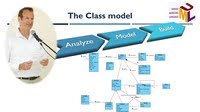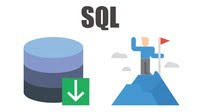
In this article you can find online Business Analysis courses to master your skills.
Business analysis is a professional discipline of identifying business needs and determining solutions to business problems. Solutions often include a software-systems development component, but may also consist of process improvements, organizational change or strategic planning and policy development. The person who carries out this task is called a business analyst or BA.
Business analysts do not work solely on developing software systems. But work across the organisation, solving business problems in consultation with business stakeholders. Whilst most of the work that business analysts do today relate to software development/solutions, this derives from the ongoing massive changes businesses all over the world are experiencing in their attempts to digitise.
Although there are different role definitions, depending upon the organization, there does seem to be an area of common ground where most business analysts work. The responsibilities appear to be:
- To investigate business systems, taking a holistic view of the situation. This may include examining elements of the organisation structures and staff development issues as well as current processes and IT systems.
- To evaluate actions to improve the operation of a business system. Again, this may require an examination of organisational structure and staff development needs, to ensure that they are in line with any proposed process redesign and IT system development.
- To document the business requirements for the IT system support using appropriate documentation standards.
In line with this, the core business analyst role could be defined as an internal consultancy role that has the responsibility for investigating business situations, identifying and evaluating options for improving business systems, defining requirements and ensuring the effective use of information systems in meeting the needs of the business.
Below we present 15 online business analysis courses to expand your knowledge.
The Class model – Systems Analysis and Digital Product
Yosi Wiesel via Udemy
Building the Class model guides you by a very structured and solid method on how to understand and analyze the domain. It really forces you to think in a structured way; It doesn’t let you delude yourself that you understand the business world because it forces you to build a model: With strict logic and rules and in well–defined language (UML) with a wealth of options. In theory, theory and practice are the same, but in practice – they are not! The course takes a very pragmatic approach. No more long and boring theoretical academic introductions, no more naive examples with no relevance to real life, and no more long educated argumentation about delicate nuances that don’t really matter in real life. Right from the start, I will introduce a real–world test case. This test case will accompany us throughout the course. In every lecture I will add more details that will reflect the complexity of real test case and will set the stage for adding more concepts and wisdom to the class model.
★★★★★(5-star rating)
What Is LEAN or AGILE Business Analysis?
Tom and Angela Hathaway via Udemy
With the widespread adoption of Agile, software development has gone through some serious remodeling. Agile teams build robust products incrementally and iteratively, requiring fast feedback from the business community to define ongoing work. As a result, the process of defining IT requirements is evolving rapidly. Backlogs replace requirements definition documents. User Stories, Epics and Features replace requirement statements. Scenarios and Examples replace test cases. The timing of business analysis activities is shifting like sand. This course is a brief overview of how you can reduce waste in Business Analysis practices to optimally support the new lean and agile software development world. You will learn about topics such as: The purpose of a product roadmap and a prioritized product backlog, The concept of a Minimum Viable Product (MVP), Agile and Lean thinking applied to requirements discovery, analysis, and acceptance testing. Lean requirement constructs such as Features, User Stories, Epics, Scenarios, Examples, etc.
★★★★★(5-star rating)
Model Scope with Use Case Diagram
Natasha Kordonska via Udemy
This course is about a foundational technique of Business Analysis, use case modeling. For those of you who have taken our Business Analysis Simplified: Master These 10 Techniques to Deliver Requirements in Less Time, you will recognize use case modeling as one of the golden techniques. This is a first course on use case modeling. It will focus on the use case diagram and explain the overall framework and why it’s so successful. So why use case modeling? In our opinion, it is the most important, useful, and efficient technique for analysis of system functional requirements. Once you learn this technique, you will not be able to approach a project without it and just like us for the last 15 years, will become a use case aficionado! As with all our courses, this course is focused on practice. You will work through a software development project as it’s being delivered by a Business Analyst, named Laura, so that you can see use case diagram is applied in a real–life scenario. You will also have an opportunity to practice use case diagram technique in the assignment section of the course.
★★★★★(5-star rating)
The Ultimate Guide: Learn Trello – Beginner to Advanced
Amit Arora via Udemy
Trello is a free cloud based software used by millions of people worldwide. My job as your instructor is to cut that learning curve on how to navigate Trello. Not only will this course cut your learning time in half it’ll cut your project planning worries by 100%. And, since Trello is a free platform, your entire team can now have their own account. You don’t have to share passwords with anyone – Hallelujah! Whether it’s for wedding, thank you cards, or even your honeymoon, Trello helps your team stay organized. You’re in control of who gets to see what, by controlling the privacy of your boards. Think of Trello as Pinterest on steroids……
★★★★★(5-star rating)
Purpose Driven Business Analyst Career – Advance
Amit Gupta via Udemy
Welcome to Guru’s Odyssey programme on being a Purpose Driven Business Analyst for Practical Skills & Advance Guidance. Our aim at Guru’s Odyssey is to bring common sense approach to every aspect of project delivery in all sectors taking example of complex Investment Banking project so that projects can be delivered on time and with highest quality for the clients. We hope that this course will raise enough questions in your mind about being an effective and efficient Business Analyst but at the same time provide details explanations / answers to some of these questions. This course will provide some guidance by raising questions on practical skills you must focus on to be a [Lead] Business Analyst. Our Moto is Strong Roots, Smarter Generation and we strongly believe that if we work together then we will be able to build a smart work force who work on delivering good value for internal and external clients and build a solid foundation for the organisation along with personal growth.
★★★★★(5-star rating)
Business Metrics for Data-Driven Companies (FREE)
Daniel Egger via Coursera
In this course, you will learn best practices for how to use data analytics to make any company more competitive and more profitable. You will be able to recognize the most critical business metrics and distinguish them from mere data. You’ll get a clear picture of the vital but different roles business analysts, business data analysts, and data scientists each play in various types of companies. And you’ll know exactly what skills are required to be hired for, and succeed at, these high–demand jobs. Finally, you will be able to use a checklist provided in the course to score any company on how effectively it is embracing big data culture. Digital companies like Amazon, Uber and Airbnb are transforming entire industries through their creative use of big data. You’ll understand why these companies are so disruptive and how they use data–analytics techniques to out–compete traditional companies.
★★★★★(5-star rating)
Business Analysis: Master Stakeholder Profiling in 6 Steps
Roxanne Miller via Udemy
Learn how to more effectively identify, negotiate for, and engage the necessary stakeholder resources for your next project through the power of stakeholder profiling. This course is designed for those seeking to improve their ability to: By the end of the course, you will be able to: The ideal student for this course is the: This course includes 9 modules, 31 lectures, 2 hours and 6 minutes of videos, 10 quizzes, 3 downloadable quick–reference job aids, and a complimentary PDF of Chapter 2: Involve the Right Stakeholders from Roxanne Miller s book The Quest for Software Requirements. Enroll now and gain access to the stakeholders you need!
★★★★★(5-star rating)
Agile Business Analysis: Getting / Writing Lean Requirements
Tom and Angela Hathaway via Udemy
In this course, you will learn how the concepts of Agile, Lean, and Continuous Delivery software development philosophies influence the discovery, expression, and analysis of business needs. You will learn how to express those needs in user story format, as features or requirement statements, and ultimately as Given–When–Then structures. This is the language that allows developers to deliver the IT solutions the organization needs. The single largest challenge facing organizations around the world is how to leverage their Information Technology to gain competitive advantage. This is not about how to program the devices, it is determining what the devices should do. The skills required to identify and define the best IT solutions are invaluable for every role in the organization. These skills can propel you from the mail room to the boardroom by making your organization more effective and more profitable.
★★★★★(5-star rating)
Business Analysis Simplified
Natasha Kordonska via Udemy
This course is about a simple repeatable approach on using the 10 key Business Analysis techniques that will help you deliver requirements on every project, every time. In this course, you will learn a failure proof, consistent approach to deliver requirements successfully every time. Through our years of experience in the Business Analysis industry, we have applied a variety of techniques on projects with various degree of successes. And in the end, we took our learning and boiled it down to the 10 BABOK techniques that are absolute must haves when applied with our approach. While other techniques are helpful, the 10 you will learn about in this course are foundational for all Business Analysis work you will do. Once you master these techniques and approach, you will confidently deliver requirements in any business domain, application, or industry.
★★★★★(5-star rating)
Business Analysis: Data Flow Diagrams to Visualize Workflows
Tom and Angela Hathaway via Udemy
Learn about Data Flow Diagrams (DFDs), Context–level DFDs, and Rigorous Physical Process Models (RPPM), what they are, why they are important, and who can use them. Getting from someone’s explanations of how they do their job to usable and accurate workflow descriptions can be a daunting proposition. Understanding current workflows, however, is critical to defining a future IT solution. Just as critical is understanding how data is created and consumed throughout the workflow. To truly understand problems inherent in a business process or workflow, you need to help the practitioners visualize what they do. Visualization lets them identify better ways of working that remove current restrictions. ata Flow Diagrams are phenomenal tools for visualization. Working with business experts, you can help them identify problems and inefficiencies they don t even know they have.
★★★★(4-star rating)
Create Better Requirements with Use Cases
Natasha Kordonska via Udemy
This course is about a foundational technique of Business Analysis, use cases. For those of you who have taken our Business Analysis Simplified: Master These 10 Techniques to Deliver Requirements in Less Time, you will recognize use case modeling as one of the golden techniques. This is our second course on use case modeling. Our first course, Business Analysis Simplified – Model Use Case Diagram, focused on the use case diagram and the overall framework and why it’s so successful. In this course, we are taking a deep dive into the use cases and explain how to document detailed requirements with use case technique. So why use case modeling? In our opinion, it is the most important, useful, and efficient technique for analysis of system functional requirements. Once you learn this technique, you will not be able to approach a project without it and just like us for the last 15 years, will become a use case aficionado!
★★★★(4-star rating)
(PMI PBA ) Business Analysis Simulation Exams
Eng. Shaban Osman via Udemy
Join this course to practice on simulation exams to pass PMI PBA. Actually, you can do this in a short time. One 100 questions simulation exam. One 130 questions simulation exam. One 150 questions simulation exam. Three 200 questions simulation exams.In most of our explanation, you will find the reference as the above along with the process number, for example, PMI BA Guide 7.1 (This means that you can review additional information from chapter 7 and process number one for this question. Keep studying and solve these exams more than once. You can pause the test at any time and resume later. You can retake the test as many times as you would like. The progress bar at the top of the screen will show your progress as well as the time remaining in the test. If you run out of time, don’t worry; you will still be able to finish the test. You can skip a question to come back to at the end of the exam.
★★★★(4-star rating)
Business Analyst – SQL Survival Guide
Daniel Gater via Udemy
Are you a business analyst and have either avoided getting to know SQL, or haven’t had the opportunity? Or, maybe you just want to a quick start to the basics of SQL without the advanced functions? If you’ve answered yes to any of these then this course is for you. Starting with the absolute basics, this course covers; What a database is, How applications use databases, Entity Relationship Diagrams, What a data warehouse is and how organisations use them, What software you’ll need to connect to a database, How to create your own test database, The essential SQL commands you’ll need to query data from one or many tables in a SQL database, Commands you’ll need to manipulate data (insert, update, and delete),How to export data to Excel.To a business analyst, data is king. Accurate data is the easiest and most powerful way to prove or disprove a hypothesis or course of action, the challenge is getting your hands on it. If you don’t have access or the skills to query a database you are reliant on someone else getting the data that you’ve asked for, which might not be what you want.
★★★★(4-star rating)
Business Analysis: Simple and Practical Guide
Samer Rahhal via Udemy
Business Analysts are in high demand across a wide range of industries. For people who possess needed skillset, it can be an exciting and rewarding career. Business Analysis help struggling companies thrive and make good companies great. Online coursework is a great way to assess skills, train, and gain insights outside of certification. With this course practical guide for business analysis we will be targeting beginners’ to intermediate analysts with focus of requirements documentation, elicitation, APIs and provide examples on the way.
★★★★(4-star rating)
CommonSensical Technical Documentation
Deena Chadwick via Udemy
For thousands of years, man has been struggling with the ability to effectively communicate and record information. The ever–changing world of IT (Information Science and Technology) has added to that struggle. Hundreds of templates, methodologies, and experts are willing to provide you with help. Do they make it easier, or just add to the complication? Commonsensical Technical Documentation is a guide to simple, lean, and agile technical writing. This course is targeted to business analysts, project managers, and technical writers at all levels. Those just starting out who want to learn more about creating good documentation as well as seasoned writers who just want to add more polish to their deliverables. If you have ever found yourself writing boring or complicated documentation, then you are sure to find useful information in this course.
★★★★(4-star rating)

















